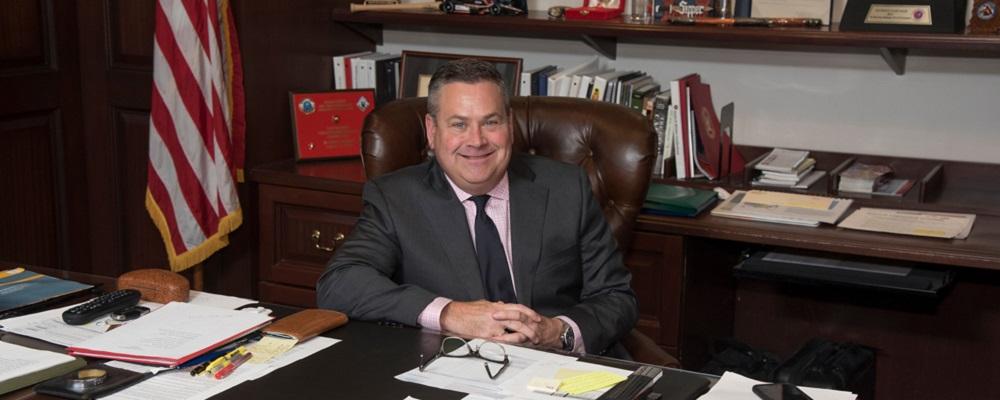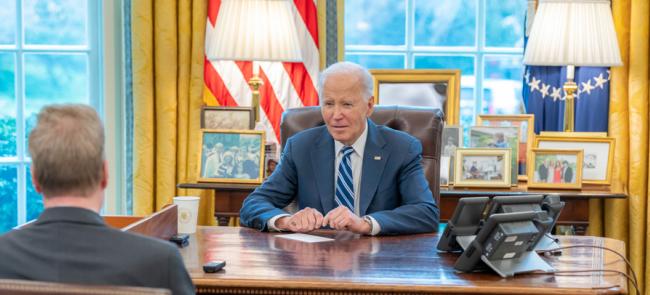
Force of Nature
America may have just completed its toughest year in decades while the National Guard, in many respects, had one of its best. The Guard’s profile has never been higher. Some are calling 2020 the Year of the Guard. That can only help us going forward. I just wish it had come under different circumstances.
Our country suffered a great deal last year, but the pain would have been far worse if not for the men and women of the Guard. Examples abound.
Beginning in March, millions of Americans were able to put food on the table because Guardsmen at food banks provided them groceries. Others were able to learn if they had the coronavirus because Guardsmen staffed testing sites. Many were able to get unemployment benefits because Guardsmen working at call centers talked them through the application process.
I could go on and on. The array of Guard COVID-19 missions is vast and many have had an impact on our fellow citizens. And they’ve increased during the vaccine rollout.
But that’s far from all the Guard did last year. When powder kegs emerged amid protests nationwide last summer, Guardsmen brought calm to many cities. No small achievement; civil unrest may be the most difficult mission in the Guard’s domestic portfolio.
National Guard Bureau data speaks to the volume of the tandem responses. During one week in June, nearly 90,000 Guardsmen were mobilized for domestic operations. That’s almost double the previous high. Another 30,000 were overseas.
The number receded quickly as most of the civil unrest missions were brief, but governors nationwide called the Guard for other tasks — storms along the Gulf Coast, a record wildfire season out West and election cybersecurity, to name a few.
From news articles we’ve seen from across the country, Guardsmen won praise from officials wherever they served, from health department chiefs and food bank managers to call center administrators and election authorities. The common refrain? These men and women really care about their community.
We weren’t the only ones who saw these stories. I can’t count how many times we called a member of Congress or their staff to share the Guard story and they told us what the Guard was doing in their district or state.
So we shared the rest of the story. We explained that these part-time soldiers and airmen left families and work or school behind to help their fellow citizens. We told them that the men and women with whom the nation has become so reliant often don’t receive the same benefits as their active-component and Reserve counterparts.
Our focus was medical coverage for those on COVID-19 duty. Only those on federal Title 32 orders of more than 30 days were eligible. That applied to many but not all of those on the front lines. Some were on state active duty, which essentially provides no health care.
Another issue was transitional health care. The law didn’t provide medical coverage beyond the completion of a domestic mission. It does following an overseas assignment, but not after responding to the worst public health crisis in a century.
We also told lawmakers and their staffs about the lack of equipment parity with active forces. Many Guardsmen were in harm’s way with vehicles and aircraft no longer advanced enough for active-component forces.
We asked for help. Did we get everything we need? No. Competition for finite resources is always fierce. But we made progress.
Your membership gives us the mandate we need to be your voice and turn your requirements into reality.
ADVOCACY ON CAPITOL HILL has long been best accomplished in person. That’s why we built the National Guard Memorial, our headquarters in Washington, D.C., close by. Lawmakers and their staffs are only a short walk away. And we take full advantage of it.
That often wasn’t possible in 2020. Not with so much of Washington working from home to slow the spread of COVID-19, including our staff.
But we adapted. We had to, tens of thousands of mobilized Guardsmen needed a voice. Using phone calls, texts and email to leverage existing relationships on the Hill, we were able to get a lot done. Given the circumstances, it was one of our biggest sets of legislative accomplishments in years.
Our first order of business at the beginning of the shutdown was convincing federal authorities to move mobilizations that began on state active duty to Title 32, the provision in federal law that covers the Guard’s federal mission while under state control.
We succeeded, but the initial Title 32 authorization only allowed orders in increments of 30 days, one day short of eligibility for TRICARE. So we went back to work with lawmakers and the media in an effort to convince decision-makers to make it 31 days.
One more day was our mantra, and the authorization was changed accordingly.
Next was transitional medical coverage for those on COVID-19 duty. That required a legislative solution, which took some time, but it was included in the fiscal 2021 National Defense Authorization Act enacted early this year.
The NDAA also included a paid maternity program with retirement credits for drill-status women in the Guard and Reserve. It’s essentially the reserve-component equivalent of what women on active duty have had since 2016.
Additional language authorizes the NGB chief to submit a list of unfunded priorities to Congress to support Guard responsibilities for the homeland defense and civil support missions.
Both provisions were NGAUS priorities. The association also helped expand some popular veterans’ benefits to more Guardsmen and their families.
One is credit for the first time for service under Title 32 toward Department of Veterans Affairs’ home loans. The threshold is 90 cumulative days on Title 32 with at least one period of 30 consecutive days.
Additional language extends federal employment protections and reemployment rights to Guardsmen who serve at least 14 days of state active duty or who are mobilized to respond to a national emergency or natural disaster.
NGAUS also won some major equipment battles in 2020. One of the most significant is the six C-130J Super Hercules cargo planes Congress added to 2021 defense appropriations for the Air Guard. They weren’t in the defense budget proposal; the Air Force is no longer requesting C-130s.
Six more C-130Js means there will be enough new aircraft to convert another Guard C-130H wing to the more advanced J-model in the coming years. The Air Force announced plans in late 2020 to convert three Guard H-model units to new aircraft. Now, it will be four.
Lawmakers also added funds for six HH-60M Black Hawk medevac helicopters for the Army Guard. They are among 43 new or rebuilt Black Hawks in fiscal 2021 appropriations for the Army Guard. The figure is a product of our work directly with Army officials for a few years to reinforce the urgency of Guard aviation needs.
The same jobs and risks warrant the same equipment and benefits.
OUR LEGISLATIVE PRIORITIES this year build on our successes in 2020. We seek further progress toward parity with the active component on equipment, resources and benefits. The same jobs and risks warrant the same equipment and benefits.
One example is credit toward the Post-9/11 GI Bill. Active-component personnel get it every day they serve. Reservists receive credit when they go to schools. Guardsmen only get it on Title 32 when they are responding to a presidential emergency.
There will be legislative efforts this year to remedy that.
We will also be looking for Congress to consider Zero-Cost TRICARE regardless of activation status. Zero cost means zero cost to everyone in uniform — no premium, no co-pays, no deductibles.
The overall price will scare off the Pentagon. But such a program would bolster recruiting, retention and medical readiness, resulting in significant cost avoidance. It would also make Guardsmen more attractive to employers.
Duty-status reform is also on our agenda. The Defense Department has been working for quite some time on draft legislation that would combine the more than 30 duty statuses into broad categories that create parity for service members, whether they are fighting insurgents, a wildfire or the coronavirus.
We support the effort in principle, but it’s a huge undertaking that involves hundreds of changes to federal law and regulations. It could easily go awry.
Congress will receive the Pentagon proposal at some point. It’s already two years overdue. We’ll be watching and will engage when it arrives to ensure the final bill increases benefits parity and maintains the state role in mobilizing Guardsmen.
The Guard’s high profile should help with all of this. So will a strong and active membership. In fact, it’s critical. Your membership gives us the mandate we need to be your voice and turn your requirements into reality.
We took a slight step backward in the membership area in 2020. COVID-19 hindered the effort. I think a return to normalcy will trigger a rebound.
The pandemic affected multiple other NGAUS programs we hope to resume sometime in 2021. One is our Capitol Summit program. It brings company-grade officers, warrant officers and chief warrant officer 2s to the nation’s capital to see how our association and Washington works.
We increased the event to two full days in the nation’s capital in 2019 and added a third iteration. Unfortunately, we were only able to conduct one summit last year, and that was virtual. We received great feedback, but watching a computer monitor just can’t compare to gathering in person and seeing things for yourself.
That also applies to our annual conference. The pandemic forced us to transition from an in-person gathering in Boston to a virtual event. We had four members of the Joint Chiefs of Staff and a presidential candidate speak. Again, we received great feedback, but I hope it’s our first and last virtual conference. An in-person event is simply more productive for all involved.
Count me among those optimistic about the rollout of the vaccine. I’m looking forward to seeing old Guard friends and making some new ones at an in-person conference this year. We also have some unfinished association business that needs our attention.
Let me conclude by thanking you for all you did in 2020. You made a tough year for many Americans a little easier. And people across the nation, including here on Capitol Hill, noticed.
Have a safe and prosperous 2021. And rest assured, even a pandemic can’t stop us from giving you a voice in Washington.
Retired Brig. Gen. J. Roy Robinson is the NGAUS president. He can be reached at president@ngaus.org.



